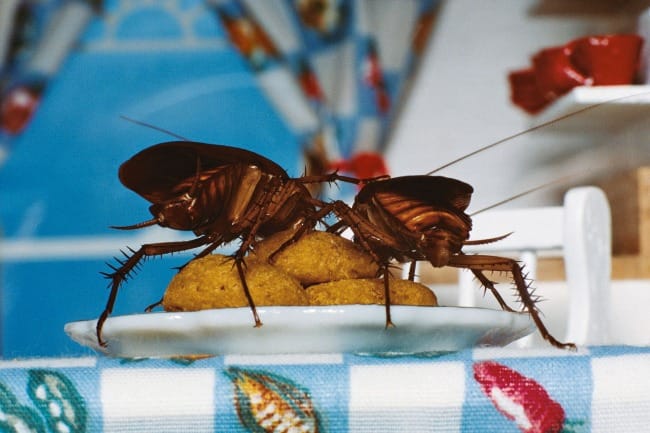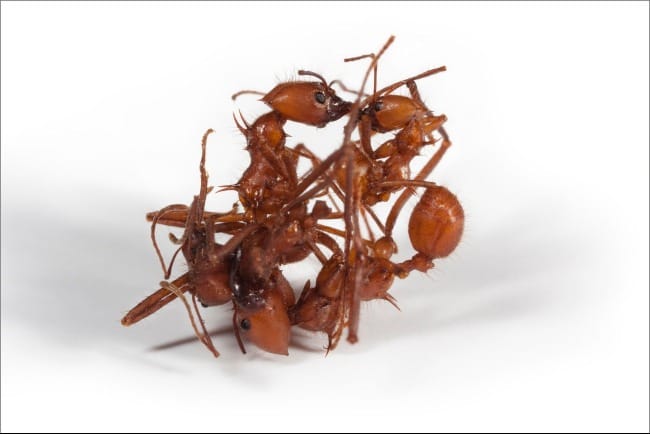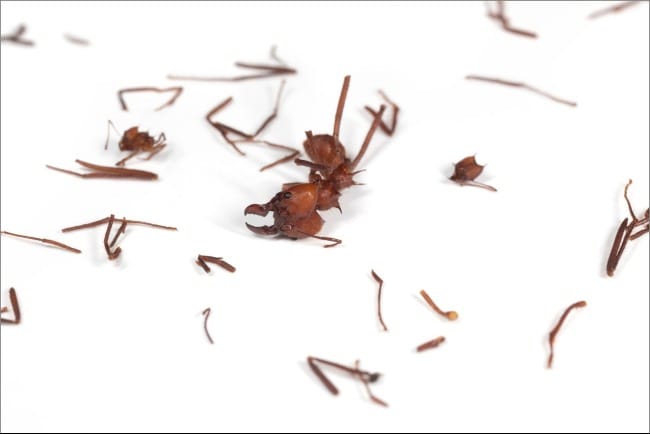If you don't quite know what to think of the work of Catherine Chalmers, you're not alone. Her videos, photographs, drawings, and sculptures often feature casts of characters who by themselves arouse antipathy (such as cockroaches). In addition, the circumstances she shows them in are sometimes far from the picturesque shots of nature we might put up on or walls or include in our calendars. (One series focuses on creatures eating each other). Her work challenges the easy lines we draw between ourselves and other creatures and between what is of value and what isn't.

The Lines We Draw
It is interesting to consider how we categorize what is appealing and what is disgusting. As Chalmers says, Humanity has been drawing lines in the sand forever, defining what is in and what is out, maybe now, at the dawn of the Anthropocene, is a good time to reconsider those lines and what lives on the other side.
For instance, the cockroach. Why do so many of us to react in disgust and antipathy toward this creature? Why does the mere thought of one repulse me personally? Is it the cockroach's fault or mine that I am unable or unwilling to accept it as a valued part of the creation? As a pastor once said from the pulpit, loving God's creation includes loving the cockroach. Whenever we elevate our likes and dislikes into a place of judgment as to the value of something, we risk not respecting and valuing them as they ought to be respected and valued. We make our own likes and dislikes equivalent to the Creator's.
Chalmers' work also calls into question the wide chasm that we have created between ourselves and other creatures, confronting us with the question, "Are we as different from other creatures as we might think we are?" Considering the activities Chalmers show us in her work, we might wish to think we are entirely different from these creatures, but a closer look suggests otherwise.
A Different Perspective
The societal behavior she records sheds light on both the particular animal society she is observing (be it cockroaches or ants), but can, in addition, cast a new light on the behavior of human society. Through the work, we may see similarities between these societies that we might not otherwise see or want to see. The War series, including shots of the defeated ant as a pile of body parts strewn across the fighting surface, has this effect. Its images of a fight-to-the-death conflict gives us a powerful image for the outcome of war—whether it be between ants or humans.


War, Catherine Chalmers
Through her artful presentations, Catherine Chalmers slips viewers through a side door of perspective where we find an unaccustomed view of human nature and human interaction. Her works strip away the constructs we put on human behavior—showing these acts of collaboration and competition in a different context and in this way helps us see parallels and metaphors for human interactions. We can see commonalities between "us" (humans) and "them" (the creatures) we are watching and because different species are demonstrating the behavior, we see it differently.
Works of Collaboration
When Catherine Chalmers plans her productions, she can never completely predict how they will turn out. That's because the participants don't follow her directions; they act out their own impulses, and they tend to be unpredictable—as one might expect from wild creatures which one can't direct or control. Her collaborators, who have ranged from rats and snakes to cockroaches and ants, continue to surprise her (and sometimes confound her), often making the art she creates a surprise even to herself.
" I never work alone. My colleagues just don’t happen to be human." 1
Although she delves deeply into research before each project, even to the extent of living for long periods of time with the creatures she is including in her project (and even after the project is complete), the creatures remain unpredictable. Knowing their habits and preferences is no guarantee of their behavior. Just because they ate a particular leaf type yesterday, there is no assurance that they will do that on the day that she's making her recordings—a reality she experiences firsthand.
Often, the inexplicable happens—they ignore a leaf they have been happily munching on earlier; they start ignoring a flower they have spent hours gathering as soon as Chalmers puts one their path so she can photograph it. Many aspects of her creative work remain outside of her control.
"Every narrative that I have planned, they always rewrite it," says Chalmers. 2
Leafcutters at Work
All of these elements can be seen in the multimedia "Leafcutters" project featuring the leafcutter ants of Costa Rica. Their colonies are extremely complex—according to biologist E.O. Wilson, they are second only in their complexity to human societies. Chalmers' works of collaboration with the ants raise questions about language, ritual, war, and art and our blithe assumptions of how these separate us from all other creatures.
It also raises questions about our insatiable use of resources. As we watch the ants denude an entire tree, the parallel between our consumption of entire forests is almost impossible to ignore. According to Chalmers, "They do not clear cut rainforests quite like we do, but they can strip a tree in a single night, and repeat this night after night. At a time in history when humans are causing deforestation at an alarming rate, this insect provides rich and relevant opportunities for illuminating man's impact on the environment."
I encourage you to watch the fascinating "Antworks" video below, one in her series looking at leafcutter ants. Take notice of both the individual ants and the community interactions. What strikes you as noteworthy? Does anything about the activities of the ants make you uncomfortable? Does anything remind you of human activity? Is there anything you find fascinating or beautiful? Does it give you a slightly different perspective on the differences and commonalities between humans and other creatures?
To see more in this video series and other work by Catherine Chalmers, visit her website.
To leave a comment, click below or contact me directly at info@circlewood.online.
Louise
